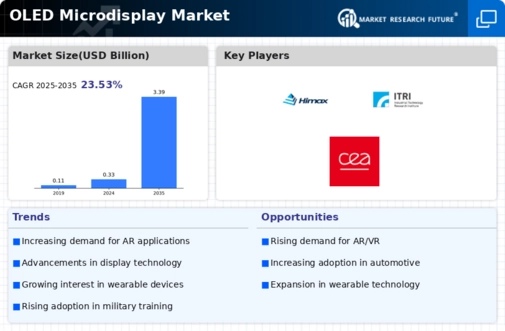Top Industry Leaders in the OLED Microdisplay Market

Competitive Landscape of the OLED Microdisplay Market:
The OLED microdisplay market is a burgeoning segment within the broader display industry. This miniature marvel, boasting high pixel density and compact size, is finding its way into a diverse range of applications, from near-to-eye (NTE) displays in augmented reality (AR) headsets to electronic viewfinders (EVFs) in high-end cameras. As the market heats up, understanding the competitive landscape becomes crucial for both established players and aspiring entrants.
Key Players:
- Sony Corporation
- LG Display Co., Ltd.
- Samsung Electronics Co., Ltd
- OSRAM Licht AG
- Dresden Microdisplay GmbH
- Kopin Corporation
- Yunnan OLiGHTEK Opto-Electronic Technology Co., Ltd
- Himax Technologies, Inc.
- Holoeye Photonics AG
- Seiko Epson Corporation
- Fraunhofer Fep
- Industrial Technology Research Institute (ITRI)
- Cea-Leti
- JBD Inc
Strategies Adopted by Key Players:
The current competitive landscape features a mix of established display giants and nimble startups, each vying for a slice of the pie. Here's a snapshot of some key players and their adopted strategies:
- eMagin: A veteran in the NTE display space, eMagin leverages its proprietary AMOLED technology and focus on high-resolution, high-brightness displays for military and industrial applications.
- Kopin Corporation: Another major player in NTE displays, Kopin Corporation boasts a diverse product portfolio and strong partnerships with AR/VR headset manufacturers.
- Sony Semiconductor Solutions Corporation: A tech giant with deep expertise in OLED technology, Sony caters to the high-end consumer electronics market with its microdisplays for EVFs and head-up displays (HUDs).
- MicroOLED: A French company specializing in near-eye displays for AR/VR, MicroOLED stands out for its innovative µLED technology offering ultra-high brightness and resolution.
- Winstar Display Co. Ltd.: A Taiwanese manufacturer known for its cost-effective OLED microdisplays, Winstar targets the industrial and medical sectors with a focus on affordability and reliability.
Market Share Analysis:
Analyzing market share in the OLED microdisplay market goes beyond mere sales figures. Here are some key factors to consider:
- Technology Expertise: Proprietary OLED technologies, backplane architectures, and driver ICs can give certain players a significant edge in terms of display performance, power efficiency, and cost.
- Product Portfolio Diversification: Offering a variety of microdisplay resolutions, sizes, and configurations caters to a wider range of applications and customer needs.
- Vertical Integration: In-house production of key components like OLED materials and backplanes can ensure better quality control and potentially lower costs.
- Application Focus: Specializing in specific application segments, like AR/VR or medical imaging, can create a strong foothold and brand recognition.
- Geographical Presence: A global reach with manufacturing and sales networks close to key markets is essential for efficient supply chain management and customer support.
New Entrants and Emerging Trends
The OLED microdisplay market is constantly evolving, attracting new players and witnessing the emergence of exciting trends:
- MicroLED Technology: While still in its early stages, microLED technology promises even higher brightness, contrast, and efficiency compared to OLED, potentially disrupting the market in the future.
- Focus on AR/VR: With the AR/VR market expected to boom, companies are developing specialized microdisplays optimized for wearability, low power consumption, and wider field of view.
- Medical Applications: OLED microdisplays are finding their way into medical devices like surgical microscopes and retinal implants, creating a niche market with high growth potential.
Industry Developments
Sony Corporation:
- Focus on high-resolution displays: Sony showcased a prototype 4K micro-OLED display with a pixel density of 4000ppi at SID Display Week 2023 (October 2023) (Nikkei Asian Review, Oct 26, 2023).
- Collaboration with Kopin Corp.: Sony and Kopin announced a partnership in July 2023 to develop high brightness microdisplays for AR/VR applications.
- Investment in microdisplay production: Sony reportedly invested around $115 million in expanding its microdisplay production capacity in Japan in June 2023 (The Elec, June 5, 2023).
LG Display:
- Focus on large-area microdisplays: LG Display is reportedly developing microdisplays as large as 2 inches diagonally, targeting applications like AR smart glasses and head-mounted displays (HMDs).
- Focus on flexible displays: LG Display showcased a prototype flexible microdisplay at SID Display Week 2023, opening up possibilities for curved AR/VR devices.
- Acquisition of eMagin: In May 2023, LG Display acquired leading microdisplay manufacturer eMagin for $218 million, gaining access to eMagin's advanced technology and market expertise.
